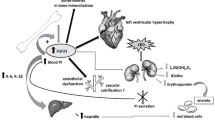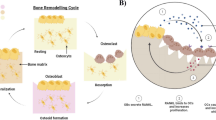Abstract
Summary
This work examines the skeletal accumulation of fluorescently tagged zoledronate in an animal model of chronic kidney disease. The results show higher accumulation in 24-h post-dose animals with lower kidney function due to greater amounts of binding at individual surfaces.
Introduction
Chronic kidney disease (CKD) patients suffer from increased rates of skeletal-related mortality from changes driven by biochemical abnormalities. Bisphosphonates are commonly used in reducing fracture risk in a variety of diseases, yet their use is not recommended in advanced stages of CKD. This study aimed to characterize the accumulation of a single dose of fluorescently tagged zoledronate (FAM-ZOL) in the setting of reduced kidney function.
Methods
At 25 weeks of age, FAM-ZOL was administered to normal and CKD rats. Twenty-four hours later, multiple bones were collected and assessed using bulk fluorescence imaging, two-photon imaging, and dynamic histomorphometry.
Results
CKD animals had significantly higher levels of FAM-ZOL accumulation in the proximal tibia, radius, and ulna, but not in lumbar vertebral body or mandible, based on multiple measurement modalities. Although a majority of trabecular bone surfaces were covered with FAM-ZOL in both normal and CKD animals, the latter had significantly higher levels of fluorescence per unit bone surface in the proximal tibia.
Conclusions
These results provide new data regarding how reduced kidney function affects drug accumulation in rat bone.



Similar content being viewed by others
References
Coresh J, Selvin E, Stevens LA, Manzi J, Kusek JW, Eggers P, van Lente F, Levey AS (2007) Prevalence of chronic kidney disease in the United States. JAMA 298:2038–2047. https://doi.org/10.1001/jama.298.17.2038
Moe S, Drüeke T, Cunningham J, Goodman W, Martin K, Olgaard K, Ott S, Sprague S, Lameire N, Eknoyan G, Kidney Disease: Improving Global Outcomes (KDIGO) (2006) Definition, evaluation, and classification of renal osteodystrophy: a position statement from Kidney Disease: Improving Global Outcomes (KDIGO). In: Kidney Int pp 1945–1953, 69
McNerny EMB, Nickolas TL (2017) Bone quality in chronic kidney disease: definitions and diagnostics. Curr Osteoporos Rep 15:207–213. https://doi.org/10.1007/s11914-017-0366-z
Malluche HH, Porter DS, Monier-Faugere M-C, Mawad H, Pienkowski D (2012) Differences in bone quality in low- and high-turnover renal osteodystrophy. J Am Soc Nephrol 23:525–532. https://doi.org/10.1681/ASN.2010121253
Malluche HH, Porter DS, Pienkowski D (2013) Evaluating bone quality in patients with chronic kidney disease. Nat Publ Group 9:671–680. https://doi.org/10.1038/nrneph.2013.198
Nitsch D, Mylne A, Roderick PJ, Smeeth L, Hubbard R, Fletcher A (2009) Chronic kidney disease and hip fracture-related mortality in older people in the UK. Nephrol Dial Transplant 24:1539–1544. https://doi.org/10.1093/ndt/gfn678
Burr DB, Allen MR (2011) Bisphosphonates and PTH for preventing fractures. In: Skeletal aging and osteoporosis. Springer Berlin Heidelberg, Berlin, Heidelberg, pp 151–176
Eastell R, Walsh JS, Watts NB, Siris E (2011) Bisphosphonates for postmenopausal osteoporosis. Bone 49:82–88. https://doi.org/10.1016/j.bone.2011.02.011
Ketteler M, Block GA, Evenepoel P, Fukagawa M, Herzog CA, McCann L, Moe SM, Shroff R, Tonelli MA, Toussaint ND, Vervloet MG, Leonard MB (2017) Executive summary of the 2017 KDIGO Chronic Kidney Disease-Mineral and Bone Disorder (CKD-MBD) Guideline update: what’s changed and why it matters. Kidney Int 92:26–36. https://doi.org/10.1016/j.kint.2017.04.006
Kidney Disease: Improving Global Outcomes (KDIGO) CKD-MBD Work Group (2009) KDIGO clinical practice guideline for the diagnosis, evaluation, prevention, and treatment of chronic kidney disease-mineral and bone disorder (CKD-MBD). Kidney Int Suppl 76:S1–S130. https://doi.org/10.1038/ki.2009.188
Perazella MA, Markowitz GS (2008) Bisphosphonate nephrotoxicity. Kidney Int 74:1385–1393. https://doi.org/10.1038/ki.2008.356
Miller PD (2014) Chronic kidney disease and the skeleton. Bone Res 2:14044–14013. https://doi.org/10.1038/boneres.2014.44
Green JR, Seltenmeyer Y, Jaeggi KA, Widler L (1997) Renal tolerability profile of novel, potent bisphosphonates in two short-term rat models. Pharmacol Toxicol 10.100 80:225–230
Pfister T, Atzpodien E, Bohrmann B, Bauss F (2005) Acute renal effects of intravenous bisphosphonates in the rat. Basic Clin Pharmacol Toxicol 97:374–381. https://doi.org/10.1111/j.1742-7843.2005.pto_160.x
Haffner D, Fischer D-C (2011) Can bisphosphonates play a role in the treatment of children with chronic kidney disease? Pediatr Nephrol 26:2111–2119. https://doi.org/10.1007/s00467-010-1739-z
Shih AWY, Weir MA, Clemens KK, Yao Z, Gomes T, Mamdani MM, Juurlink DN, Hird A, Hodsman A, Parikh CR, Wald R, Cadarette SM, Garg AX (2012) Oral bisphosphonate use in the elderly is not associated with acute kidney injury. Kidney Int 82:903–908. https://doi.org/10.1038/ki.2012.227
Toussaint ND, Elder GJ, Kerr PG (2009) Bisphosphonates in chronic kidney disease; balancing potential benefits and adverse effects on bone and soft tissue. Clin J Am Soc Nephrol 4:221–233. https://doi.org/10.2215/CJN.02550508
Miller PD (2007) Is there a role for bisphosphonates in chronic kidney disease? Semin Dial 20:186–190. https://doi.org/10.1111/j.1525-139X.2007.00271.x
Allen MR, Aref MW (2017) What animal models have taught us about the safety and efficacy of bisphosphonates in chronic kidney disease. Curr Osteoporos Rep 15:171–177. https://doi.org/10.1007/s11914-017-0361-4
Allen MR, Newman CL, Chen N, Granke M, Nyman JS, Moe SM (2014) Changes in skeletal collagen cross-links and matrix hydration in high- and low-turnover chronic kidney disease. Osteoporos Int 26:977–985. https://doi.org/10.1007/s00198-014-2978-9
Moe SM, Chen NX, Newman CL, Organ JM, Kneissel M, Kramer I, Gattone VH II, Allen MR (2015) Anti-sclerostin antibody treatment in a rat model of progressive renal osteodystrophy. J Bone Miner Res 30:499–509. https://doi.org/10.1002/jbmr.2372
Newman CL, Moe SM, Chen NX, Hammond MA, Wallace JM, Nyman JS, Allen MR (2014) Cortical bone mechanical properties are altered in an animal model of progressive chronic kidney disease. PLoS One 9:e99262. https://doi.org/10.1371/journal.pone.0099262
Allen MR, Chen NX, Gattone VH, Chen X, Carr AJ, LeBlanc P, Brown D, Moe SM (2012) Skeletal effects of zoledronic acid in an animal model of chronic kidney disease. Osteoporos Int 24:1471–1481. https://doi.org/10.1007/s00198-012-2103-x
Moe SM, Radcliffe JS, White KE, Gattone VH II, Seifert MF, Chen X, Aldridge B, Chen NX (2011) The pathophysiology of early-stage chronic kidney disease-mineral bone disorder (CKD-MBD) and response to phosphate binders in the rat. J Bone Miner Res 26:2672–2681. https://doi.org/10.1002/jbmr.485
Moe SM, Chen NX, Seifert MF, Sinders RM, Duan D, Chen X, Liang Y, Radcliff JS, White KE, Gattone VH II (2009) A rat model of chronic kidney disease-mineral bone disorder. Kidney Int 75:176–184. https://doi.org/10.1038/ki.2008.456
Hokugo A, Sun S, Park S, McKenna CE, Nishimura I (2013) Equilibrium-dependent bisphosphonate interaction with crystalline bone mineral explains anti-resorptive pharmacokinetics and prevalence of osteonecrosis of the jaw in rats. Bone 53:59–68. https://doi.org/10.1016/j.bone.2012.11.030
Kashemirov B, Bala J, Chen X et al (2008) Fluorescently labeled risedronate and related analogues: “magic linker” synthesis. Bioconjug Chem 19:2308–2310
Pautke C, Vogt S, Tischer T, Wexel G, Deppe H, Milz S, Schieker M, Kolk A (2005) Polychrome labeling of bone with seven different fluorochromes: enhancing fluorochrome discrimination by spectral image analysis. Bone 37:441–445. https://doi.org/10.1016/j.bone.2005.05.008
Kozloff KM, Quinti L, Patntirapong S, Hauschka PV, Tung CH, Weissleder R, Mahmood U (2009) Non-invasive optical detection of cathepsin K-mediated fluorescence reveals osteoclast activity in vitro and in vivo. Bone 44:190–198. https://doi.org/10.1016/j.bone.2008.10.036
Kozloff KM, Volakis LI, Marini JC, Caird MS (2010) Near-infrared fluorescent probe traces bisphosphonate delivery and retention in vivo. J Bone Miner Res 25:1748–1758. https://doi.org/10.1002/jbmr.66
Fuchs RK, Allen MR, Condon KW, Reinwald S, Miller LM, McClenathan D, Keck B, Phipps RJ, Burr DB (2008) Strontium ranelate does not stimulate bone formation in ovariectomized rats. Osteoporos Int 19:1331–1341. https://doi.org/10.1007/s00198-008-0602-6
Recker RR, Kimmel DB, Dempster D, Weinstein RS (2011) Issues in modern bone histomorphometry. Bone 49:955–964. https://doi.org/10.1016/j.bone.2011.07.017
Dempster DW, Compston JE, Drezner MK, Glorieux FH, Kanis JA, Malluche H, Meunier PJ, Ott SM, Recker RR, Parfitt AM (2013) Standardized nomenclature, symbols, and units for bone histomorphometry: a 2012 update of the report of the ASBMR Histomorphometry Nomenclature Committee. J Bone Miner Res 28:2–17. https://doi.org/10.1002/jbmr.1805
Lin JH (1996) Bisphosphonates: a review of their pharmacokinetic properties. Bone 18:75–85
Sato M, Grasser W, Endo N, Akins R, Simmons H, Thompson DD, Golub E, Rodan GA (1991) Bisphosphonate action. Alendronate localization in rat bone and effects on osteoclast ultrastructure. J Clin Invest 88:2095–2105. https://doi.org/10.1172/JCI115539
Roelofs AJ, Thompson K, Gordon S, Rogers MJ (2006) Molecular mechanisms of action of bisphosphonates: current status. Clin Cancer Res 12:6222s–6230s. https://doi.org/10.1158/1078-0432.CCR-06-0843
Drake MT, Clarke BL, Khosla S (2008) Bisphosphonates: mechanism of action and role in clinical practice. Mayo Clin Proc 83:1032–1045. https://doi.org/10.4065/83.9.1032
Cremers S, Papapoulos S (2011) Pharmacology of bisphosphonates. Bone 49:42–49. https://doi.org/10.1016/j.bone.2011.01.014
Roelofs AJ, Stewart CA, Sun S, Błażewska KM, Kashemirov BA, McKenna CE, Russell RGG, Rogers MJ, Lundy MW, Ebetino FH, Coxon FP (2012) Influence of bone affinity on the skeletal distribution of fluorescently labeled bisphosphonates in vivo. J Bone Miner Res 27:835–847. https://doi.org/10.1002/jbmr.1543
Turek J, Ebetino FH, Lundy MW, Sun S, Kashemirov BA, McKenna CE, Gallant MA, Plotkin LI, Bellido T, Duan X, Triffitt JT, Russell RGG, Burr DB, Allen MR (2012) Bisphosphonate binding affinity affects drug distribution in both intracortical and trabecular bone of rabbits. Calcif Tissue Int 90:202–210. https://doi.org/10.1007/s00223-012-9570-0
Plotkin L, Weinstein R, Parfitt A et al (1999) Prevention of osteocyte and osteoblast apoptosis by bisphosphonates and calcitonin. J Clin Invest 104:1363–1374
Plotkin L, Manolagas S, Bellido T (2006) Dissociation of the pro-apoptotic effects of bisphosphonates on osteoclasts from their anti-apoptotic effects on osteoblasts/osteocytes with novel analogs. Bone 39:443–452
Ott SM (2009) Bone histomorphometry in renal osteodystrophy. Semin Nephrol 29:122–132. https://doi.org/10.1016/j.semnephrol.2009.01.005
Moe SM, Chen NX, Newman CL, Gattone VH II, Organ JM, Chen X, Allen MR (2014) A comparison of calcium to zoledronic acid for improvement of cortical bone in an animal model of CKD. J Bone Miner Res 29:902–910. https://doi.org/10.1002/jbmr.2089
Nancollas GH, Tang R, Phipps RJ, Henneman Z, Gulde S, Wu W, Mangood A, Russell RGG, Ebetino FH (2006) Novel insights into actions of bisphosphonates on bone: differences in interactions with hydroxyapatite. Bone 38:617–627. https://doi.org/10.1016/j.bone.2005.05.003
Ebetino FH, Hogan A-ML, Sun S, Tsoumpra MK, Duan X, Triffitt JT, Kwaasi AA, Dunford JE, Barnett BL, Oppermann U, Lundy MW, Boyde A, Kashemirov BA, McKenna CE, Russell RGG (2011) The relationship between the chemistry and biological activity of the bisphosphonates. Bone 49:20–33. https://doi.org/10.1016/j.bone.2011.03.774
Acknowledgments
Two-photon microscopy was performed in the O’Brien Center for Advanced Renal Microscopy (NIH P30 DK 079312).
Funding
This work was supported by a United States (U.S.) Department of Veterans Affairs grant (BX003025) to MRA. MWA was supported by NIH F30 DK115162 and NIH T32 AR065971 during separate portions of this work.
Author information
Authors and Affiliations
Corresponding author
Ethics declarations
All procedures conducted in this study were reviewed and approved by the Indiana University School of Medicine Institutional Animal Care and Use Committee.
Conflicts of interest
None.
Electronic supplementary material
Supplementary Figure 1
Analysis of two photon images. A) Raw image of green channel detector. B) MATLAB Input image with bone area as white and black for bone marrow. C) Analysis region with non-analyzed regions shown in grayscale. D) Pixels above FAM-ZOL threshold. (PNG 1616 kb)
Supplementary Figure 2
Bulk fluorescence assessment of whole radius and tibia from normal animals administered FAM-ZOL by either intravenous (IV) or subcutaneous (SC) injection (n = 4 per dose route). There was no significant difference in the mean group values between the two routes for either the radius or tibia sites (p > 0.60). (PNG 336 kb)
ESM 1
(DOCX 14 kb)
Rights and permissions
About this article
Cite this article
Swallow, E.A., Aref, M.W., Chen, N. et al. Skeletal accumulation of fluorescently tagged zoledronate is higher in animals with early stage chronic kidney disease. Osteoporos Int 29, 2139–2146 (2018). https://doi.org/10.1007/s00198-018-4589-3
Received:
Accepted:
Published:
Issue Date:
DOI: https://doi.org/10.1007/s00198-018-4589-3




